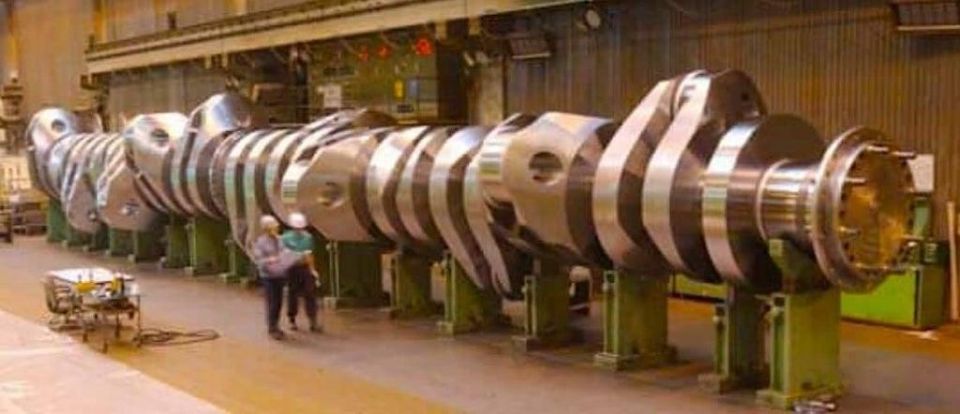

Damion Smy
Suzuki Fronx recalled after seatbelt failure sparks ‘urgent investigation’
5 Hours Ago
There's no replacement for displacement.. And this engine has 25,592 litres of that.

Contributor


Contributor
At 13.5 meters tall, 26.59 meters long and weighing in at over 2300tons, the Finnish-made Wärtsilä-Sulzer RTA96-C is the largest internal-combustion engine ever produced and pumps out a whopping 80.1MW (107,390hp).
This colossal creation is responsible for powering one of the biggest container ships ever made.

Wärtsilä-Sulzer manufactures a range of engines in this class, all of them in-line, ranging from six to 14 cylinders.
The image you have probably seen doing the rounds is not even the grand-daddy, but merely the “baby” six-cylinder.
You want stats? Here they are:
| Configuration | Turbocharged two-stroke diesel straight engine, 14 cylinders |
|---|---|
| Bore | 960mm (38in) |
| Stroke | 2500mm (8.2ft) |
| Displacement | 25,592 litres, (1,556,002 cubic inches) |
| Engine speed | 15–102 RPM |
| Power | 5720 kW per cylinder, 80,080kW (107,390hp) total |
| Torque | 7,603,850 Nm (5,608,310 lbf⋅ft) @ 102 rpm |
| Fuel consumption | 250 tons of fuel per day |
| Crankshaft weight | 300t (660,000lb) |
| Piston weight | 5.5t (12,000lb) |
| Piston height | 6 m (20ft) |
| Length | 26.59 m (87.2ft) |
| Height | 13.5 m (44ft) |
| Weight (dry) | > 2300 tons |
| Fuel type | Heavy fuel oil |
If you think the power figures are huge, just try to get your head around the torque figures. That is nearly 8 million newton metres. To put that into perspective, that’s equivalent to the torque from over 11,000 Toyota LandCruiser 300 Series’. Mind bending.
Although not too dissimilar in construction to what you might find in a modern diesel vehicle, there are a few notable differences (aside from the obvious proportions).

The top of the connecting rod is not attached directly to the piston; instead it’s connected to a “crosshead” which rides in guide channels also known as slippers. This mechanism is similar to the internals of a steam engine.
A long piston rod then connects the crosshead to the piston. This is done to minimise crankcase width. A single connecting rod between the crank and piston would require the crankcase to be much wider to accommodate the side to side motion of the connecting rod.

The use of the sliding cross head is also done so that lateral forces produced by the connecting rod are absorbed by the cross head instead of the piston. Those sideways forces are what elongate regular cylinders into an oval shape over time.
These mammoth engines are two-stroke diesels, with uniflow-exhaust scavenging, essentially similar to the famous two-stroke Detroit Diesels. The have intake ports openings in the cylinder barrels, and the spent gases exhaust via valves at the top of the cylinder head, actuated hydraulically.




Perhaps one of the most impressive statistics of this monster is its fuel efficiency. Something that is imperative for its role in powering cargo ships, where operational range and fuel consumption is measured in millions of dollars at a time.


The Wärtsilä engine powers what used to be the largest container ship in the world, the Emma Maersk. The ship measures 397m long (nearly a full 1/4mi for you drag racing folk), and has a gross tonnage of over 170,000 tons.
At full speed the Wärtsilä can propel Emma Maersk to a top speed of 25.5 knots. That is nearly 50km/h for us car guys. Not bad for something that can haul nearly 15,000 containers from one side of the world to the other.
At maximum economy the engine exceeds 50 per cent thermal efficiency. That is, more than 50 per cent of the energy in the fuel is converted to motion.
For comparison, most automotive engines struggle to surpass around 25 per cent thermal efficiency. Meaning that 75 per cent of the fuel is wasted.





The “spikes” on the piston rods are hollow tubes that go into the holes you can see on the underside of the pistons.


These inject oil into the inside of the piston which keeps the top of the piston from overheating.
This is not too dissimilar to the “oil squirters” in performance automotive engines that spray oil onto the bottom of the piston to keep them cool.

There is no need for a twin turbo setup on the RTA96-C. Big single only! This impressive exhaust driven air pump stands nearly 4 metres tall.



Given the 14-cylinder variant is unlikely to fit in your Honda, you’re in luck, since Wärtsilä also makes a smaller six-cylinder version with only 30,000hp.
If fitting one of these to your next project car is on your agenda (or if you’re just a gear-head like me), included below is the marketing material and technical specifications right from Wärtsilä-Sulzer, the proverbial horse’s mouth.
Either way it’s some interesting reading if you have a spare 10 minutes to marvel at the engineering behind this colossal beast.


















Mark Trueno is a CarExpert Contributor.


Damion Smy
5 Hours Ago


Damion Smy
6 Hours Ago


Damion Smy
8 Hours Ago


Damion Smy
10 Hours Ago


CarExpert.com.au
12 Hours Ago


Ben Zachariah
13 Hours Ago